Commonly, the name "Kalgoorlie" is simply used to refer to the twin-boom towns of Kalgoorlie and Boulder. Boulder developed primarily as
area for the gold mines.
Due to similarities between dialects and their kinship systems, the Western Desert people have been defined as a cultural bloc. They were hunter-gatherers who hunted, fished and collected wild fruits and vegetables. They did not raise animals for food or cultivate crops. Mobility was an important survival strategy.
Studies show that hunter-gatherers probably only worked about fifteen to twenty hours a week in order to survive, and the rest of the time was devoted to leisure (Sahlins). Criticism has found such views overly romantic, pointing out that hunter-gatherer people experienced extremely high infant mortality, frequent disease, and perennial warfare.
Western Desert people appeared to occupy discrete areas of land, and had a general fear of the sorcery of strangers. In the early days of the gold rush, Aboriginal Department Inspector Bailey recorded that "the tribal customs of Aboriginals forbid their entering the confines of other tribes, any departure from such
customs usually result in combat, often death".
The availability of water was a major issue for the Wangkatja people. In 1864, explorer Charles Hunt was just south of Kalgoorlie when he met a group of Aboriginal people who had come from dry country to the east, headed for the granite country to wait out the hot weather.
Hunt returning in the following year and in 1866, was told that Aboriginal people would often
travel westward during the summer dry periods.
European settlement made traditional methods of obtaining food difficult for the Wangkatja people, making game scarce and murrin murrin seeds less available.
 |
| Aboriginal people, Kalgoorlie Western Argus (WA : 1896 - 1916), Tuesday 23 November 1909 |
 |
| Aboriginal Australian - Western Australia, traditional dress, 1901 |
 |
| Bendigo Independent (Vic. : 1891 - 1918), Friday 20 November 1896 |
 |
Aboriginal rock design (painted hand marks), Mulka's Cave (Western Australia)
|
1863: Explorations
Henry Lefroy led an expedition in 1863 through the region where Coolgardie is today, just over 37km from Kalgoorlie.
Between 1864 and 1866, explorer and surveyor Charles Cooke Hunt found and
mapped water sources in the area that would later become the goldfields. Later, the telegraph line to Kalgoorlie and the first stage of the transcontinental railway line would follow Hunt's track.
In March 1869, Sir John Forrest led an expedition from Perth in search of clues to the fate of Leichhardt. The party made it almost as
far as the later site of Laverton, surveying the route using the most up-to-date methods of stellar observation.
1890s: The Gold Rush
An Irish born trio, Patrick (Paddy) Hannan, Tom Flanagan, and Dan Shea, helped spark the gold rush and the development of the boom town of Kalgoorlie, when they discovered alluvial gold whilst travelling through the area in 1893.
Hannan then filed a Reward Claim on 17 June 1893, and soon, hundreds of hopeful prospectors were rushing to the place called "Hannan's Find".
 |
Photo of Paddy Hannan in the 1920s
|
The gold at Hannan's Find was soon extinguished, and many hopeful diggers left in disappointment. However, a prospector named Sam Pearce and his partner, William George Brookman, found the real gold wealth
several kilometres south of Hannan's Find.
Initially, the area was dubbed "Brookman's sheep farm", but before long, the area revealed itself as being one of the richest gold lodes ever found and the name, "Golden Mile", began to be used.
Extreme Hardship
The early miners of the Eastern Goldfields experienced extreme hardships. Not only was the heat of the area hard to bear, but the low rainfall meant there was
little available drinking water.
The bore water was brackish and polluted and extremely expensive. Many prospectors also died of thirst when they journeyed out looking for gold, as they ran out of water and none could be found.
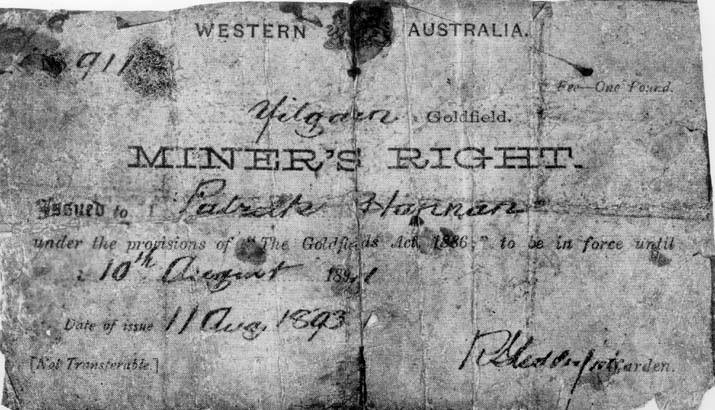 |
| Hannan's Western Australian Miner's Right, 1893 |
 |
| Prospector's camp, Kalgoorlie, WA, Kalgoorlie Western Argus (WA : 1896 - 1916), Thursday 10 September 1896 |
 |
| Camp life at Kalgoorlie, WA, Western Australian Goldfields Courier (Coolgardie, WA : 1894 - 1898), Saturday 26 June 1897 |
Some Notable People
William Brookman was in partnership with Sam Pearce when he heard about Paddy Hannan's discovery of gold at what would become Kalgoorlie.
The pair walked 300 miles (483 km) from York to Kalgoorlie, arriving on 28 June 1893. However, they moved their camp some distance from Hannan's main camp and became founders of Great Boulder in 1893.
Brookman went bankrupt, but later, he became the director of over 30 mining companies and was said to be a millionaire. He adopted a lavish lifestyle, living in a mansion,
buying land, purchasing a country estate, a seaside cottage, a private yacht and a motor car, and employing liveried servants. In 1900, Brookman was elected Mayor of Perth.
Later, Brookman experienced financial difficulties and had to sell assets to meet his debts. And his wife left him.
 |
| William Gordon Brookman (1859 –1910) |
Brookman Street, Kalgoorlie, is located parallel to Hannan Street to the north.
Richard Egan, also called "Diamond Dick", owned the Croesus Mine Lease, which he took up in 1893, covering 9 acres.
Egan creamed off the shallow gold and then sold the mine to an Adelaide Syndicate. Egan took off to the eastern states, but he was a big-spender soon lost all his money.
Egan
returned to prospecting in Western Australia and died young in 1900, aged 36. He is buried in the Kalgoorlie Cemetery.
Egan Street, which runs parallel to Hannan Street in Kalgoorlie, is named after Richard Egan.
The Grand in Kalgoorlie was the first permanent hotel on Hannan St built in 1895, by W. J. Reynolds.
 |
| Croesus Mine Lease, Kalgoorlie, WA, Kalgoorlie Western Argus (WA : 1896 - 1916) |
Kalgoorlie/Boulder got electric street lights in 1898. Before that, street lights were fuelled by gas.
Typhoid
During the 1890s, typhoid fever in the Goldfields reached epidemic proportions. It is not surprising that this infectious disease contaminated the water in the crowded mining camp of 10,000 people and camels, with no rubbish removal or sewerage system available.
Many got sick and died, and there were no hospitals or doctors.
 |
| Bathurst Free Press and Mining Journal (NSW : 1851 - 1904), Wednesday 10 March 1897 |
A Town
In 1894, the place known as "Hannan's Find" was
declared a town, and named Kalgoorlie. The name is said to be derived from the Aboriginal Wangai word "Karlkurla", meaning "place of the silky pears".
With the opening of the railway to Perth in 1896, the timber shacks of Kalgoorlie began to be replaced by splendid new buildings. There were more than 40 hotels, clubs, theatres, and even swimming pools, even though water was still in short supply.
 |
| Hannans Club at Brookman Street, Kalgoorlie, WA, built 1897. Western Mail (Perth, WA : 1885 - 1954), Friday 16 December 1898 |
The Water Problem
In 1895, Engineer-in-Chief Charles Yelverton O’Connor came up with an innovative solution for supplying water to the growing population on the goldfields by building a pipeline from the water reservoir near Perth to Kalgoorlie, a distance of 563 kilometres.
However, malicious criticism and harassment were directed at O'Connor, and he took his own life.
"Not only had they obtained the victory over the opponents of the scheme, but they had won a greater fight and a greater battle – they had conquered the great forces of Nature".
The Goldfields Water Supply Scheme was a great engineering feat, with the Helena River dammed and the water piped over 550 kilometres (340 mi) to Kalgoorlie.
In 1896, the railway arrived and connected Kalgoorlie and Boulder to Perth.
 |
| A train load of Mephan Ferguson's patent locking bar steel pipes made for the Goldfields Water Supply Scheme, W.A. |
 |
| Aboriginal people from the Mount Margaret district in the 1890s, and Dr CJ Laver, Daily News (Perth, WA : 1882 - 1950), Saturday 22 December 1934 |
 |
| Prospecting party, Kalgoorlie, WA, 1894. Out of Copyright |
 |
| Kalgoorlie Miner (WA : 1895 - 1954), Wednesday 17 May 1950 |
 |
| THE OPENING OF THE KALGOORLIE RAILWAY, WA, Australian Town and Country Journal (Sydney, NSW : 1870 - 1919), Saturday 10 October 1896 |
 |
| A group of Kalgoorlie footballers, Coolgardie Pioneer (WA : 1895 - 1901), Saturday 19 June 1897 |
The Palace Hotel was built in 1897.
 |
| The Palace Hotel, was built in 1897, Kalgoorlie, Leader (Melbourne, Vic. : 1862 - 1918, 1935), Saturday 29 October 1898 |
 |
| The Perseverance Mine, Kalgoorlie, WA, Western Australian Goldfields Courier (Coolgardie, WA : 1894 - 1898), Saturday 16 January 1897 |
In 1897, the first telephone service on the goldfields was installed that linked the Grand Hotel with the stables.
 |
| Stock Exchange, Kalgoorlie, WA, Western Australian Goldfields Courier (Coolgardie, WA : 1894 - 1898), Saturday 3 July 1897 |
 |
| Kalgoorlie Police Force and "native tracker", Kalgoorlie Western Argus (WA : 1896 - 1916), Thursday 7 October 1897 |
 |
| KALGOORLIE FIRE BRIGADE, WA. Western Australian Goldfields Courier (Coolgardie, WA : 1894 - 1898), Saturday 30 January 1897 |
 |
| The Australian XI captained by George Giffen at Kalgoorlie, 26 April 1897, SLWA |
 |
| A KALGOORLIE SCENE. ARRIVAL OF THE EASTERN MAIL, WA. Western Mail (Perth, WA : 1885 - 1954), Friday 22 July 1898 |
 |
| The Palace Hotel, Kalgoorlie, WA, Kalgoorlie Western Argus (WA : 1896 - 1916), Thursday 6 October 1898 |
 |
| Kalgoorlie, WA, Weekly Times (Melbourne, Vic. : 1869 - 1954), Saturday 10 September 1898 |
 |
| Mining plant on Brookman Bro.'s Boulder, Lt,d, Boulder, WA. Western Mail (Perth, WA : 1885 - 1954), Saturday 9 December 1899 |
 |
| The Aboriginal dinner, Kalgoorlie, WA, Western Mail (Perth, WA : 1885 - 1954), Friday 13 January 1899 |
 |
| Kalgoorlie miners, Leader (Melbourne, Vic. : 1862 - 1918, 1935), Saturday 2 December 1899 |
 |
| View of the Associated Sulphite Mine, Kalgoorlie, WA, Western Mail (Perth, WA : 1885 - 1954), Friday 26 May 1899 |
1900s
In the early 1900s Kalgoorlie had a population of over 30,000, including the town of Boulder.
 |
Employees of the Trafalgar Gold Mine, Kalgoorlie, ca. 1900. L-R. Back Row: Rush Day, Devepserff?, Mannisberg, Unknown, Andersen, Deusch, Challenger, Nelson, Warrell. Centre: Bobbie Hill, McMurrow, T. Grey, D. O'Grady, F. Long, ? Long, Noble, Nel
|
 |
A Miner's camp at Kalgoorlie-Boulder, early 1900s. Aussie Mobs
|
 |
| Kalgoorlie as seen from the post office, Western Mail (Perth, WA : 1885 - 1954), Saturday 22 December 1900 |
 |
| Camel Team carting Sandalwood, Kalgoorlie - circa 1900, Kaye |
 |
| State School in Kalgoorlie, W.A. - early 1900s, Kaye |
 |
| Typical camps on mining leases, Kalgoorlie, W.A. - very early 1900s, Kaye |
 |
| Lake View and Star Gold Mine, Kalgoorlie-Boulder, W.A. - early 1900s, Kaye |
 |
| York and Orient Hotels, Kalgoorlie, Western Australia, circa 1900 |
 |
| View of Kalgoorlie, WA,near Mt. Charlotte - circa 1900. Kaye |
 |
| Piesse St, Boulder, WA, Kalgoorlie Western Argus (WA : 1896 - 1916), Tuesday 25 December 1900 |
 |
| Railway Station, Boulder City, Western Australia - very early 1900s, Kaye |
 |
| Kalgoorlie, WA, Kalgoorlie Western Argus (WA : 1896 - 1916), Tuesday 25 December 1900 |
In 1901 the population of Kalgoorlie was 4,793.
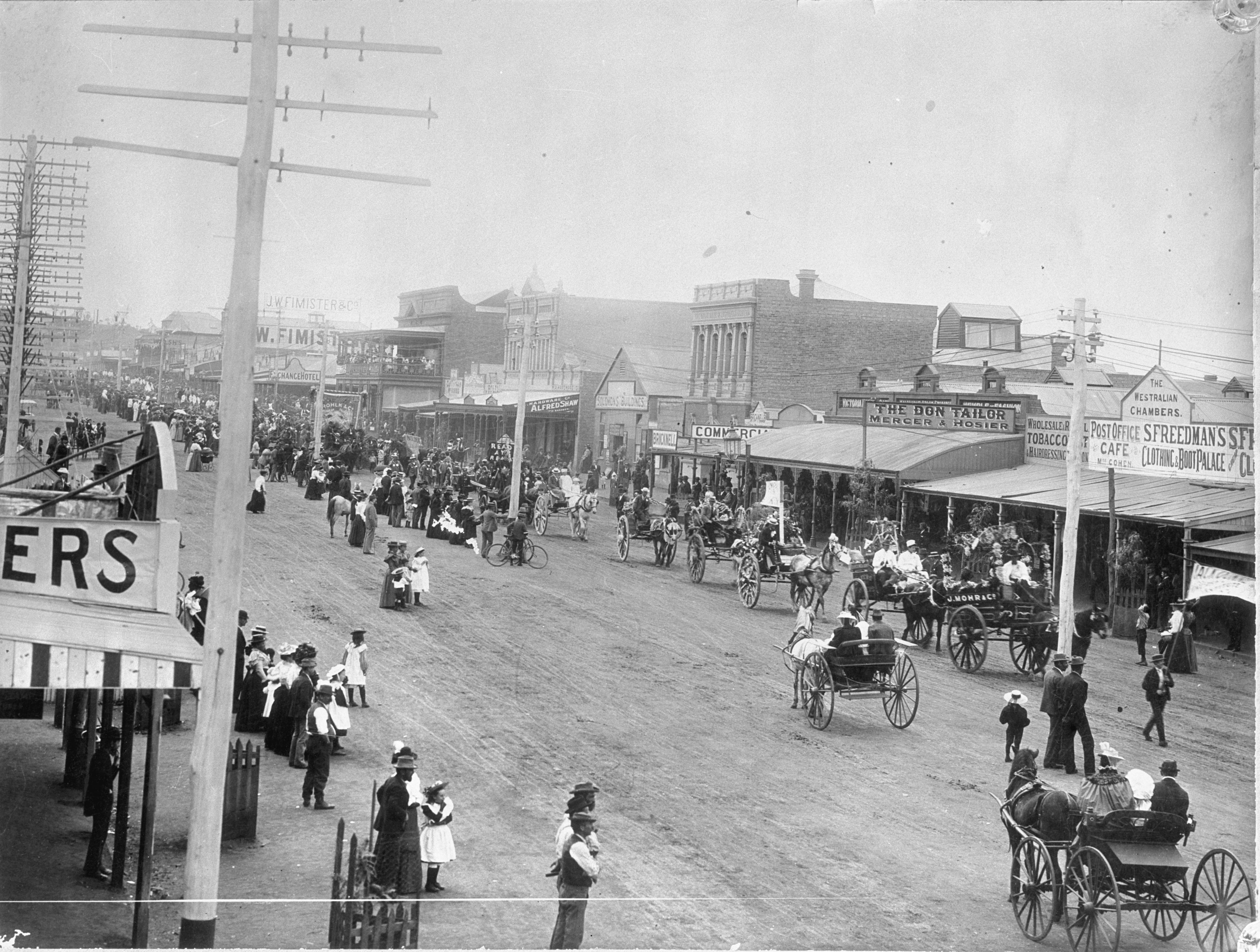 |
| Crowd watching a parade in Hannan Street, Kalgoorlie, WA, circa 1901 |
 |
| Attaching the tram lines to the poles using a horse drawn wooden scaffold, Kalgoorlie, Western Australia, 19 April 1902, National Library of Australia |
 |
| 1. Electric light plant, Boulder, WA. 2. Courthouse, Boulder, WA, Western Mail (Perth, WA : 1885 - 1954), Thursday 25 December 1902 |
The Kalgoorlie tramway operated at Kalgoorlie from 1902 until 1952.
 |
| Congregational church, Kalgoorlei, WA, Kalgoorlie Western Argus (WA : 1896 - 1916), Tuesday 2 December 1902 |
 |
Circular Church. In June, 1902, plans were formed for the planting of a new church between
the Boulder Block and Golden Gate, Kalgoorlie, WA, Kalgoorlie Western Argus (WA : 1896 - 1916), Tuesday 2 December 1902 |
 |
| Boulder City Brewery, WA, Western Mail (Perth, WA : 1885 - 1954), Saturday 19 December 1903 |
 |
| Kalgoorlie, WA, Western Mail (Perth, WA : 1885 - 1954), Saturday 19 December 1903 |
 |
| Kalgoorlie Electric Tramways, WA, Kalgoorlie Western Argus (WA : 1896 - 1916), Tuesday 24 March 1903 |
 |
| The reticulated water, which was subsidised by the State government, allowed the establishment of market gardens at Kalgoorlie, WA, Western Mail (Perth, WA : 1885 - 1954), Saturday 22 August 1903 |
 |
| OPENING OF ST. MARY'S ROMAN CATHOLIC CHURCH, KALGOORLIE, WA, Kalgoorlie Western Argus (WA : 1896 - 1916), Tuesday 1 December 1903 |
 |
| Boulder, WA, Western Mail (Perth, WA : 1885 - 1954), Sunday 25 December 1904 |
 |
| KALGOORLIE, LOOKING EAST FROM THE POST OFFICE TOWER. WA, Western Mail (Perth, WA : 1885 - 1954), Sunday 25 December 1904 |
 |
| LADIES' CRICKET MATCH, OPERA COMPANY v. KALGOORLIE, WA, Kalgoorlie Western Argus (WA : 1896 - 1916), Tuesday 8 August 1905 |
 |
| Kalgoorlie Ladies Cricket Team, 1907 |
 |
| Boulder, WA, Western Mail (Perth, WA : 1885 - 1954), Saturday 29 December 1906 |
 |
| 1. Bookmakers Lawn 2. Inside the Birdcage, Boulder Summer Meeting. WA, Kalgoorlie Western Argus (WA : 1896 - 1916), Tuesday 24 March 1908 |
 |
| Aboriginal Christmas gathering, Kalgoorlie Western Argus (WA : 1896 - 1916), Tuesday 14 January 1908 |
 |
| Tornado in Kalgoorlie, WA, Kalgoorlie Western Argus (WA : 1896 - 1916), Tuesday 10 March 1908 |
 |
| The new Anglican Church, Kalgoorlie, WA, Western Mail (Perth, WA : 1885 - 1954), Saturday 1 May 1909 |
 |
Hannan Street, Kalgoorlie, W.A. - 1909. Kaye
|
 |
| Boulder City Brass Band, Boulder, Western Australia, 1910. Individuals Identified: Glass, P.; Goltz, B.; Harris, J. (Secretary); Scott, Balfour Esq (President); McMahon, Hugh; Pereras, J. Esq (Vice President); Trenberth, Hallmon (Harry); Trenberth, (First Name Unknown). Museums Victoria |
 |
| Sydney Mail and New South Wales Advertiser (NSW : 1871 - 1912), Wednesday 16 February 1910 |
 |
| Aboriginal people, Kalgoorlie Western Argus (WA : 1896 - 1916), Tuesday 12 September 1911 |
 |
| Camels packing timber during construction of the Trans-Australian Railway - 1912 to 1917, Kaye |
The Trans-Australian Railway opened in 1917 and goes across the Nullarbor Plain from Port Augusta in South Australia to Kalgoorlie in Western Australia.
WWI
 |
PTE. H. H. HEMINGWAY. 11th Battalion. Died of wounds. Fourth son of Mr. A. Hemingway,
loco, foreman. Kalgoorlie.Sunday Times (Perth, WA : 1902 - 1954), Sunday 19 September 1915 |
 |
| PTE. ALAN JOHNSON, Killed in action; Kalgoorlie. Born in Coolgardie, WA, Sunday Times (Perth, WA : 1902 - 1954), Sunday 26 August 1917 |
1920s
 |
Railway Hotel, Kalgoorlie, Western Australia - 1921. Kaye
|
 |
| Sun (Kalgoorlie, WA : 1898 - 1929), Sunday 20 November 1921 |
 |
| Sunday Times (Perth, WA : 1902 - 1954), Sunday 2 December 1923 |
 |
| During a visit to Kalgoorlie, in Western Australia, the Prime Minister (Mr. S. M. Bruce) opened the Health Laboratory recently established in that town. Chronicle (Adelaide, SA : 1895 - 1954), Saturday 28 March 1925 |
Murder
Gold Stealing Detection Unit officers John Walsh and Alexander Pitman were found dead in a mine shaft in April 1926. They were killed and thrown down the mine shaft by gold thieves William Coulter and Phillip Treffene.
 |
| Mirror (Perth, WA : 1921 - 1956), Saturday 12 June 1926 |
 |
| Truth (Sydney, NSW : 1894 - 1954), Sunday 19 September 1926 |
 |
Golden Mile, Kalgoorlie, WA, 1928
|
 |
| Kalgoorlie Railway Station, Western Australia, 1928, Donna Barber |
1930s
 |
Aboriginal people, Kalgoorlie, Western Australia - 1930. Kaye
|
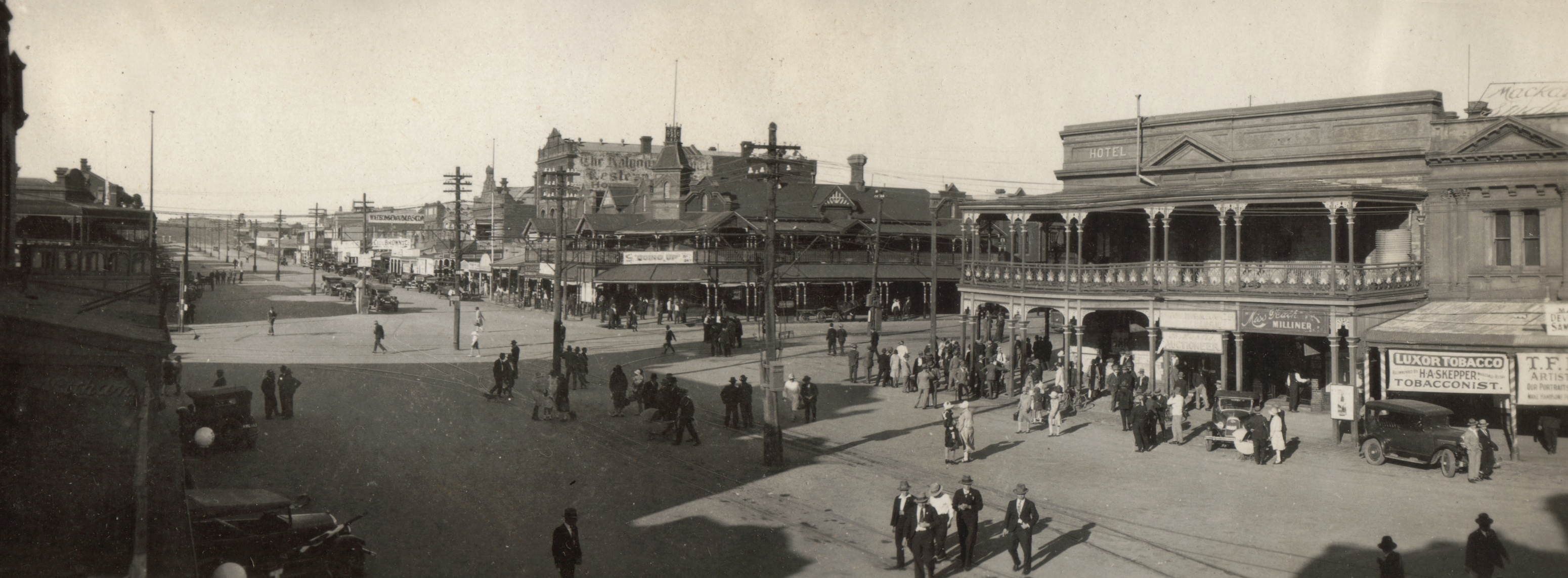 |
Hannan Street in September 1930: The Exchange Hotel is at the centre, with the Palace Hotel on the right. Kaye
|
 |
| Boulder City, Kalgoorlie, Western Australia - 1930, Kaye |
The Golden Eagle Nugget
The Golden Eagle Nugget is believed to be one of the largest nuggets ever found in the entire world. It was found by the 16 year-old son of Jim Larcombe near the abandoned town of Widgimooltha in the Kalgoorlie gold mining region.
 |
| WHEN THE PREMIER AND HIS PARTY RETURNED from the East the 'Golden Eagle' nngget was waiting for them at Kalgoorlie. The top picture shows the Premier with his hand lovingly resting on the big piece ot gold, while Mr. Claude deBernales is standing hi the background. The bottom picture was taken in the Commonwealth Bank and among those grouped around the nugget are Sir James Mitchell, Mr. Scaddan,Mirror (Perth, WA : 1921 - 1956), Saturday 24 January 1931 |
After a fight between an Italian barman and Australian, Edward Jordan, which results in Jordan's death, anti-migrant riots break out 29 January 1934.
 |
| RUINED EXTERIOR of the Cornwall Hotel, Boulder City. — The interior was gutted by fires started by the rioters in their racial outbreak against Kalgoorlie gold fields foreigners, following an altercation which resulted in the death of a British fireman, Sun (Sydney, NSW : 1910 - 1954), Friday 2 February 1934 |
 |
| Sydney Mail (NSW : 1912 - 1938), Wednesday 7 February 1934 |
 |
| News (Adelaide, SA : 1923 - 1954), Wednesday 7 February 1934 |
 |
| Miners' dugouts, Kalgoorlie, WA,West Australian (Perth, WA : 1879 - 1954), Wednesday 2 May 1934 |
Memorial Tree
 |
| Paddy Hannan's granddaughter plants tree, Kalgoorlie WA, Mirror (Perth, WA : 1921 - 1956), Saturday 2 November 1935 |
Claude Albo de Bernales
Claude Albo de Bernales (1876-1963) migrated to the Western Australian goldfields in 1897 from England.
In 1909, he became managing director of the Kalgoorlie Foundry, a major supplier of mining plant. From 1911-13, he was a member of the Kalgoorlie Chamber of Mines and became a mining promoter. His methods and dealings were in many ways questionable, but his mining activities helped keep the State afloat.
 |
| West Australian (Perth, WA : 1879 - 1954), Tuesday 17 November 1936 |
 |
| Coolgardie Miner (WA : 1935 - 1954), Thursday 27 January 1938 |
 |
| A Sunday morning crowd at the Kalgoorlie municipal swimming baths. In the background are the tanks into which water is pumped after use in the baths.is later used to water the adjoining municipal gardens. Western Mail (Perth, WA : 1885 - 1954), Thursday 8 March 1934 |
1940s and WWII
 |
| Hannan Street, Kalgoorlie, Western Australia - circa 1940, Kaye |
 |
| Hannan Street, Kalgoorlie, Western Australia - circa 1940, Kaye |
 |
| Mrs Graffin and five sons who have all served with the A.I.F. One of the sons was killed in action at Crete, Sunday Times (Perth, WA : 1902 - 1954), Sunday 13 September 1942 |
 |
| Wounded Aboriginal man: Pte J. Graham of Kalgoorlie was wounded both at Lae and in the Middle East. Australasian (Melbourne, Vic. : 1864 - 1946), Saturday 23 October 1943 |
 |
| Sunday Times (Perth, WA : 1902 - 1954), Sunday 24 September 1944 |
 |
| Kalgoorlie Cup, WA, Western Mail (Perth, WA : 1885 - 1954), Thursday 1 September 1949 |
1950s |
| Burt St, Boulder, WA, Western Mail (Perth, WA : 1885 - 1954), Thursday 14 September 1950 |
 |
| Kalgoorlie Miner (WA : 1895 - 1954), Thursday 13 August 1953 |
 |
| West Australian (Perth, WA : 1879 - 1954), Saturday 27 February 1954 |
1970s
 |
| Kalgoorlie, WA, 1979, Nick |
1980s |
| Bicentennial train: Locomotive 3801 departing from Kalgoorlie station, May 1988. NEGa009, yaruman5 |
 |
| The Flying Scotsman, 4472, at Kalgoorlie Station, May 1988, part of the Bicentennial Train Journey across Australia. yaruman5 |
Kalgoorlie was amalgamated with the Shire of Boulder to form the City of Kalgoorlie-Boulder on 15 April 1989. Open-cut mining also commenced at this time.
1990sAround Kalgoorlie
 |
| Located in Hay Street Kalgoorlie, WA, is one of the world's oldest working brothels. Questa Casa has been in known operation for 114 years and is possibly the worlds oldest working brothel. Also known as "THE PINK HOUSE", Questa Casa is the only remaining brothel from Kalgoorlie's gold rush era. Visiting the Madam for a tour is possible by booking at the visitor centre |
 |
| Kalgoorlie Roads Board Chambers, WA, 1901 |
 |
| Inside Kalgoorlie Town Hall, WA, circa 1908 |
 |
| Kalgoorlie Town Hall Theatre, WA |
 |
Sidney Edwin Hocking (1859–1935) founded The Kalgoorlie Miner newspaper in Kalgoorlie, Western Australia, in 1895. |
 |
The former Duke of Cornwall Hotel WA, 52 Hannan Street, Kalgoorlie, circa 1900
|
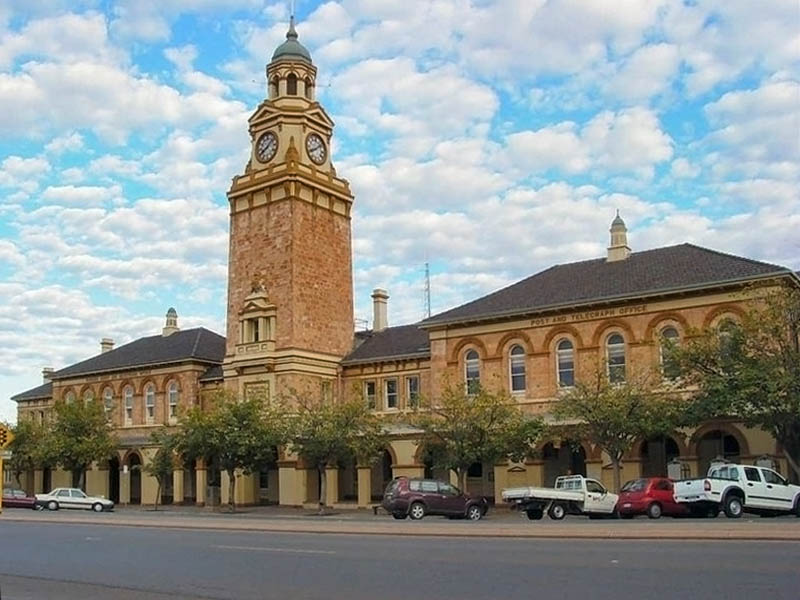 |
| Court House, Hannan Street, Kalgoorlie, WA, circa 1895 |
 |
| View of McKenzie's Buildings, cnr Hannan and Maritana Streets, Kalgoorlie, WA. circa 1904 |
 |
| Federation Free Classical Style, former Court Hotel, WA. built from 1900 |
 |
| Federation Anglo-Dutch style, York Hotel, Kalgoorlie, WA, built 1900-01 |
 |
Kalgoorlie City Markets, WA, opened on April 3, 1901
|
 |
| Hannan Street side of Palace Hotel in Kalgoorlie, circa 1897 |
.jpg) |
| The former Kalgoorlie Mechanics' Institute, WA, was built in 1902 |
.jpg) |
| Palace Chambers, in Maritana Street, Kalgoorlie, was built in 1900 |
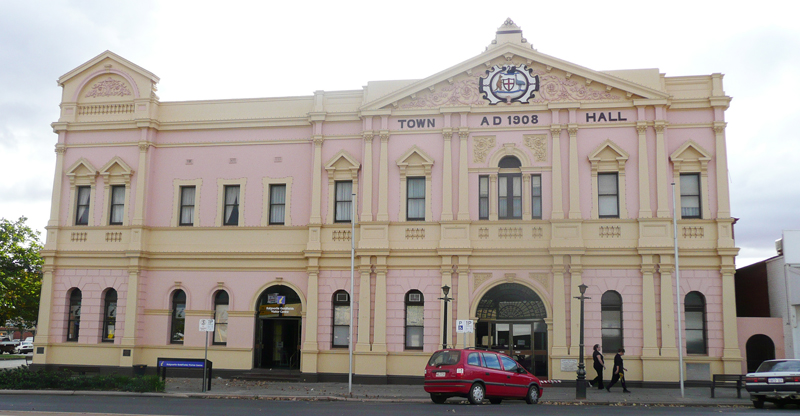 |
| The Kalgoorlie Town Hall is located on the corner of Hannan and Wilson Streets, Kalgoorlie, WA. circa 1908 |
 |
| Kalgoorlie Palace Chamber, built in Federation Free Classical style, WA, circa 1900 |
 |
| Cohn's Buildings & Tattersall's Hotel, built in the Federation Filigree style, circa 1890 - 1915, Kalgoorlie, WA |
 |
| Laslett Buildings, Kalgoorlie, WA. circa 1906-1907 |
.jpg) |
| View of the prospectors camp at the Hannans North Tourist Mine, in Kalgoorlie, WA |
 |
| Two-up school. Kalgoorlie, WA. Back in the 1950s the government made the gambling game of Two-up illegal. Two-up was legalised in Kalgoorlie in 1983 |
.jpg) |
| View of the prospectors camp at the Hannans North Tourist Mine, in Kalgoorlie WA |
.jpg) |
| View of Hannan Street, Kalgoorlie, WA |
 |
| Northern end of east side Hannan Street, Kalgoorlie WA |
 |
| The Lord Forrest Olympic Pool (1938), Kalgoorlie, WA |
 |
| Palace Theatre, Boulder. Built in 1937, Kalgoorlie,WA |
 |
| The Golden Mile and Murchison Timber Supply Company, At the Western Australian Museum, WA |
 |
| Statue of Paddy Hannan in Kalgoorlie, WA |
 |
| Metropole Hotel. Kalgoorlie - 1 Burt St Boulder, WA. opened in 1897 The hotel is famous for its mineshaft under the floor of the main bar, which was only discovered in 2002. |
 |
| Boulder Municipal Power Station, WA, constructed from 1939. Inter-War Art Deco style. |
 |
| York Hotel, Kalgoorlie, WA. The hotel was built by John Crothers in 1900-1901 for landlord and proprietor, Henry Edward Laslett. It was designed as a two-storey building in the Federation Anglo-Dutch style by architect Daniel T Edmunds |
 |
| Recreation Hotel, Kalgoorlie-Boulder, WA, designed in the Federation Free Classical style, c. 1890 - c. 1915 |
 |
| The Palace Hotel, Kalgoorlie, WA, built in 1897 |
 |
| Burt Street, Boulder, WA |
Things To Do and Places To Go



































































































.jpg)
.jpg)




.jpg)

.jpg)
.jpg)































